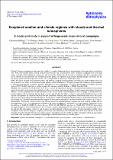Exoplanet weather and climate regimes with clouds and thermal ionospheres : a model grid study in support of large-scale observational campaigns
Abstract
Context. Gaseous exoplanets are the targets that enable us to explore fundamentally our understanding of planetary physics and chemistry. With observational efforts moving from the discovery into the characterisation mode, systematic campaigns that cover large ranges of global stellar and planetary parameters will be needed to disentangle the diversity of exoplanets and their atmospheres that all are affected by their formation and evolutionary paths. Ideally, the spectral range includes the high-energy (ionisation) and the low-energy (phase-transitions) processes as they carry complementary information of the same object. Aims. We aim to uncover cloud formation trends and globally changing chemical regimes into which gas-giant exoplanets may fall due to the host star’s effect on the thermodynamic structure of their atmospheres. We aim to examine the emergence of an ionosphere as indicator for potentially asymmetric magnetic field effects on these atmospheres. We aim to provide input for exoplanet missions such as JWST, PLATO, and Ariel, as well as potential UV missions ARAGO, PolStar, or POLLUX on LUVOIR. Methods. Pre-calculated 3D GCMs for M, K, G, F host stars are the input for our kinetic cloud model for the formation of nucleation seeds, the growth to macroscopic cloud particles and their evaporation, gravitational settling, element conservation and gas chemistry. Results. Gaseous exoplanets fall broadly into three classes: i) cool planets with homogeneous cloud coverage, ii) intermediate temperature planets with asymmetric dayside cloud coverage, and iii) ultra-hot planets without clouds on the dayside. In class ii), the dayside cloud patterns are shaped by the wind flow and irradiation. Surface gravity and planetary rotation have little effect. For a given effective temperature, planets around K dwarfs are rotating faster compared to G dwarfs leading to larger cloud inhomogeneities in the fast rotating case. Extended atmosphere profiles suggest the formation of mineral haze in form of metal-oxide clusters (e.g. (TiO2)N). Conclusions. The dayside cloud coverage is the tell-tale sign for the different planetary regimes and their resulting weather and climate appearance. Class (i) is representative of planets with a very homogeneous cloud particle size and material compositions across the globe (e.g., HATS-6b, NGTS-1b), classes (ii, e.g., WASP-43b, HD 209458b) and (iii, e.g., WASP-121b, WP 0137b) have a large day-night divergence of the cloud properties. The C/O ratio is, hence, homogeneously affected in class (i), but asymmetrically in class (ii) and (iii). The atmospheres of class (i) and (ii) planets are little affected by thermal ionisation, but class (iii) planets exhibit a deep ionosphere on the dayside. Magnetic coupling will therefore affect different planets differently and will be more efficient on the more extended, cloud-free dayside. How the ionosphere connects atmospheric mass loss at the top of the atmosphere with deep atmospheric layers need to be investigated to coherently interpret high resolution observations of ultra-hot planets.
Citation
Helling , C , Samra , D , Lewis , D , Calder , R , Hirst , G , Woitke , P , Baeyens , R , Carone , L , Herbort , O & Chubb , K L 2023 , ' Exoplanet weather and climate regimes with clouds and thermal ionospheres : a model grid study in support of large-scale observational campaigns ' , Astronomy & Astrophysics , vol. 671 , A122 . https://doi.org/10.1051/0004-6361/202243956
Publication
Astronomy & Astrophysics
Status
Peer reviewed
ISSN
0004-6361Type
Journal article
Rights
Copyright © The Authors 2023. Open Access article, published by EDP Sciences, under the terms of the Creative Commons Attribution License (https://creativecommons.org/licenses/by/4.0), which permits unrestricted use, distribution, and reproduction in any medium, provided the original work is properly cited.
Description
Funding: Ch.H. and P.W. acknowledge funding from the European Union H2020-MSCA-ITN-2019 under Grant Agreement no. 860470 (CHAMELEON). D.L. and G.H. acknowledge the School of Physics & Astronomy at the University of St Andrews for financial support of the summer project, R.C. acknowledges the Laidlaw Foundation. D.S. acknowledges financial support from the Science and Technology Facilities Council (STFC), UK. for his PhD studentship (project reference 2093954), O.H. acknowledges PhD funding from the St Andrews Center for Exoplanet Science. D.S. and O.H. acknowledge financial support from the Österreichische Akademie der Wissenschaften. R.B. acknowledges support from the KU Leuven IDN/19/028 grant ESCHER. L.C. acknowledges the Royal Society University Fellowship URF R1 211718 hosted by the University of St Andrews. K.L.C. acknowledges STFC funding under project number ST/V000861/1.Collections
Items in the St Andrews Research Repository are protected by copyright, with all rights reserved, unless otherwise indicated.

